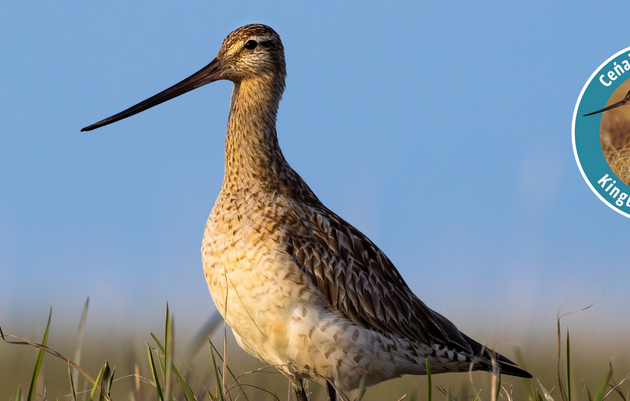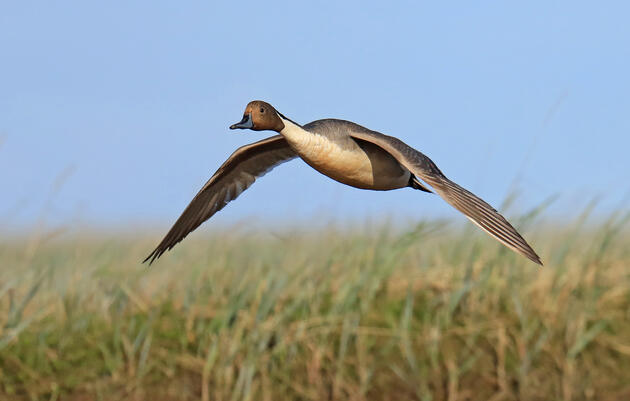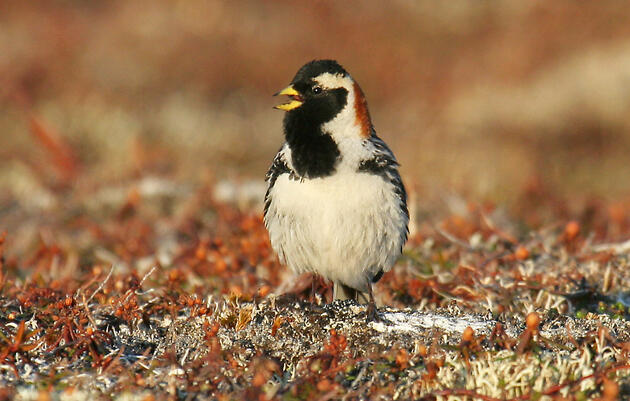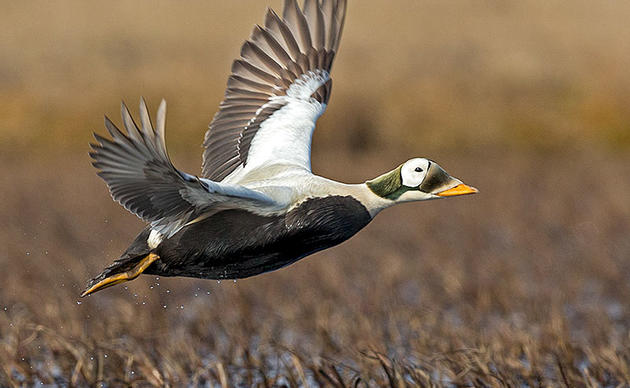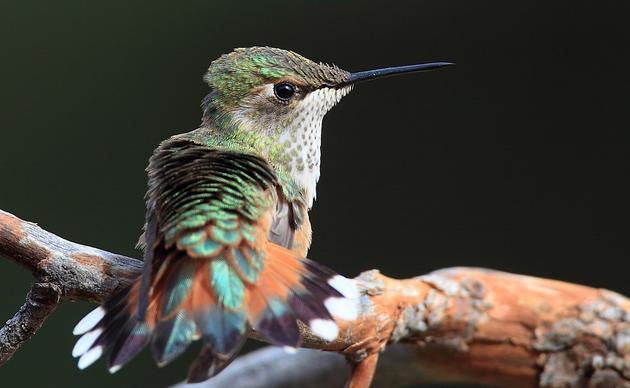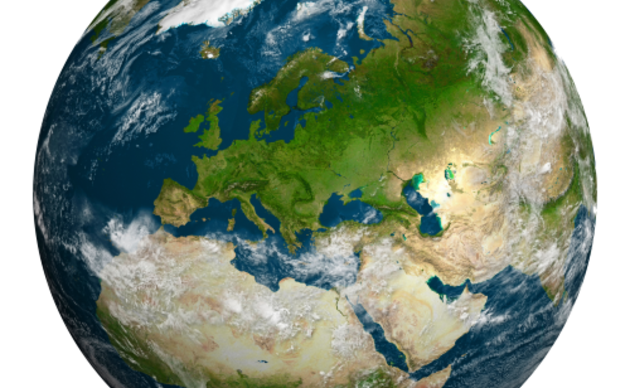The northern reaches of the Pacific Ocean can feel endless—cold gray swells rolling beneath sky-darkening clouds, thousands of seabirds riding the winds or resting in rafts on the water. Murres dive in unison, fulmars shear the waves, storm-petrels gather in flocks at night. For millennia, these seas have belonged to the birds. But today, they’re increasingly shared with something far larger: ships.
As cargo vessels thread through the Aleutians and armored oil tankers push through the Bering Strait, it’s clear that marine traffic is booming in Alaska’s waters. “A multiscale seasonal examination of the risk of harm to seabirds from vessels based on co-occurrence in Alaskan waters,” a new study published in Conservation Biology, charts, for the first time at a statewide scale, where and when seabirds and ships overlap. The findings highlight moments of risk—migration bottlenecks during stormy autumn nights and immobile molting periods—when seabirds are most vulnerable to disturbance, collisions, or disorientation.
“We were able to quantify this on a scale covering nearly the entire Alaska marine environment,” says Ben Sullender, Director of Geospatial Science at Audubon Alaska. “That really has been unprecedented to sort of put a pin in this issue and say, ‘This is where we’re at right now.’”
Where the Hotspots Are
The research team, led by postdoctoral researcher Kelly Kapsar, seabird biologist Kathy Kuletz, and Sullender, combined 16 years of seabird surveys with eight years of satellite-based vessel tracking. The result: seasonal “risk maps” showing where bird abundance and vessel density coincide.
Some hotspots were no big shocker, like Unimak Pass—the easternmost entrance through the Aleutian Islands. Publishing the Ecological Atlas of the Bering, Chukchi, and Beaufort Seas put the area on Audubon’s radar in 2017.
“I certainly was not surprised about Unimak Pass, having been through there many times,” Kuletz says. “It’s a super hot spot for boats and birds. It has been for a long time.”
The Bering Strait also stood out, though perhaps less dramatically than expected. “The Bering Strait doesn't really stand out unless you look at the North Bering and Chukchi Sea separately,” Kuletz says. “I was surprised that it didn't show up to a greater degree in the all-Alaska analysis. I think it's just swamped by what's happening in the Aleutians.”
Kapsar says one spot that did catch her attention was, “Prince William Sound showing up as a big area,” she says. “It has a lot of ferry routes and commercial fishing in the summer and is also an important nesting area … especially in summer, the vessel traffic is much higher, and that overlapped with seabirds as well.”
From Kodiak Island to the Aleutians, from Prince William Sound to the high Arctic, the maps make clear that seabirds and ships are sharing the same waters—and sometimes, the same time and space.
Why the Risk Is Rising
If birds and ships have coexisted for decades, why the concern now? One major driver is climate change. As sea ice retreats later and later in the fall, vessels can operate for longer periods, Kapsar explains. At that same time of year, daylight is declining, storm events are rising, and birds are migrating. That overlap can increase nighttime interactions, which is when we know bird strikes are most likely to occur. Some mariners have taken to calling these interactions “bird storms” —or when a flock of birds gets ensnared by the vessel’s light, with often fatal consequences.
Shifting fisheries are another factor. Russian trawlers and longliners now follow the edge of retreating sea ice northward, sometimes pushing past the Bering Strait. On the U.S. side, while fishing north of 60° latitude is restricted, vessels are still probing farther into high latitudes. “That opens up populations that hadn’t previously been exposed to fishing pressure or incidental bycatch,” says Kuletz.
Arctic resource extraction is driving more ship traffic through sensitive seabird habitats. A major influence is the Red Dog mine, which sends enormous volumes of unprocessed ore through the Bering Strait for processing elsewhere, a significant contributor to vessel traffic in the region.
And another phenomenon has to do with Russian oil and gas tankers re-routing. Sullender says the Russo-Ukrainian War has sparked Russian economic interest in making the most of whatever resources they have in their Arctic. As European markets for Russian oil have dried up, Russian tanker traffic has diverted to serve Asian markets and travel through the Bering Strait. As a result, vessel traffic through there has “been just going absolutely crazy.”
Where once the Arctic’s ice and remoteness shielded seabirds from vessels, warming seas are erasing that buffer.
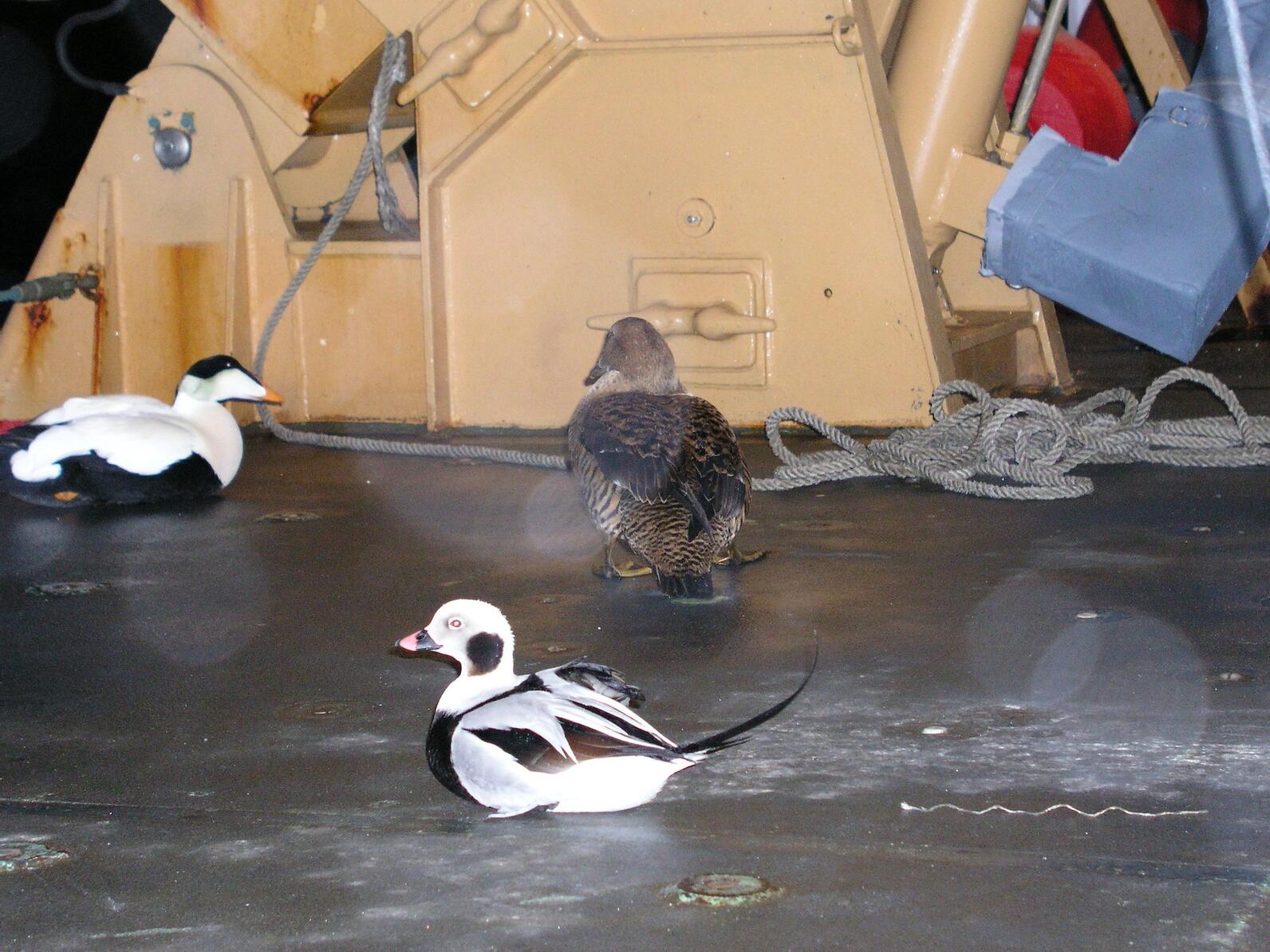
Bird Species on the Frontlines
Not all seabirds are equally at risk. Some species’ behaviors make them particularly vulnerable to disturbance or disorientation.
Take eiders, which Kuletz says are a species more impacted and disoriented by lights emitted from vessels than many others. Storm-petrels, too, which travel in very large flocks, “get disoriented and perhaps attracted to the lights on dark and stormy nights,” she says. “That’s when they run into the ships.”
Light pollution isn’t the only problem. Molting sea ducks are literally grounded. “Birds molting on the water might be subject to disturbance, not flying into the boat, but actually being disturbed as the boats are cruising through—and that’s because they’re flightless,” Kuletz explains. Juvenile murres, still flightless and dependent on their male parents at sea, are an example of a species unable to escape.
“These are literally sitting ducks that cannot fly out of the way,” Sullender adds. Discharged waste doesn't magically disappear; it just gets churned up into the ocean. “And if a vessel is passing right through a big flock of molting sea ducks right as they're discharging oily waste, for example, that could be a huge problem. That's going to stay pretty localized in that area for quite a while.”
From fulmars following fishing vessels to shearwaters rafting by the tens of thousands, each species interacts differently with ships, explains Kapsar. “It's kind of this matchup between the ecology of the species and what the ship is doing in the area.”
Conservation Measures and Maritime Realities
Kuletz recalls her own experiences on research vessels, where best practices were mandatory. Crews had to reduce lights and have someone on watch all the time to avoid going through large flocks of birds. She says fishing vessels have their own restrictions, but shipping and tourism may not.
But the good news: solutions exist, and many are already in practice. Routing ships away from seabird concentrations, setting seasonal restrictions, and dimming or shielding deck lights could dramatically reduce risks.
In fact, putting these solutions into practice has already happened twice for Alaskan waters in the last 15 years. “In the Aleutians, the International Maritime Organization designated Areas To Be Avoided around certain islands,” Sullender says. And in the Bering Strait, Audubon Alaska took a lead position in a coalition of nonprofit groups and highlighted Areas To Be Avoided, as well as recommended routes. In a separate effort, Sullender, Kapsar, and collaborators also looked at compliance rates and saw that more than 90% of vessels comply with these recommendations.
Speed limits, while effective for whales, are less clear-cut for birds. “Speed limits are not a one-size-fits-all solution,” Sullender says. “They may actually be counterproductive. They could keep boats in areas where birds hang out for longer, discharging and emitting noise and light for longer.” Thus, the team says carefully timed spatial protections should be more effective.
The team also stresses that they don’t want mariners to upend their practices, but by carefully targeting actions like minimizing light pollution at the times and places that matter most to birds, conservation efforts can be more effective in helping seabirds navigate a changing Arctic.
“Ships are not bad writ large. They’re critically important, especially in the north, for supporting small, remote communities,” Kapsar says. “We’re not out here advocating to ban shipping. We’re saying there are reasonable changes that can reduce risk to seabirds.”
Birders, Mariners, and the Path Ahead
For birders reading from afar, the problem can feel distant. But there are ways to help.
Local fishing families can play a crucial role by reporting bird strikes or mass disorientation events—the so-called bird storms—when they happen. “That would be useful information,” says Kuletz. “If it were compiled.” A summary of more information on when, where, species, and under what conditions bird strikes occur could further inform efforts to reduce such interactions.
Public engagement also matters. As the U.S. Coast Guard and the International Maritime Organization consider future routing and safety plans, they open public comment periods. Audubon Alaska gets involved directly with these efforts and works with spatial analysts within the Coast Guard to ensure that birds and other wildlife are part of the planning picture.
And for birders at home? Education and advocacy. Kuletz pointed to bird-minded groups in Hawaii that successfully pushed for shielded lights to protect petrels and shearwaters. Similar grassroots efforts could someday shape lighting standards in Alaska’s ports and harbors.
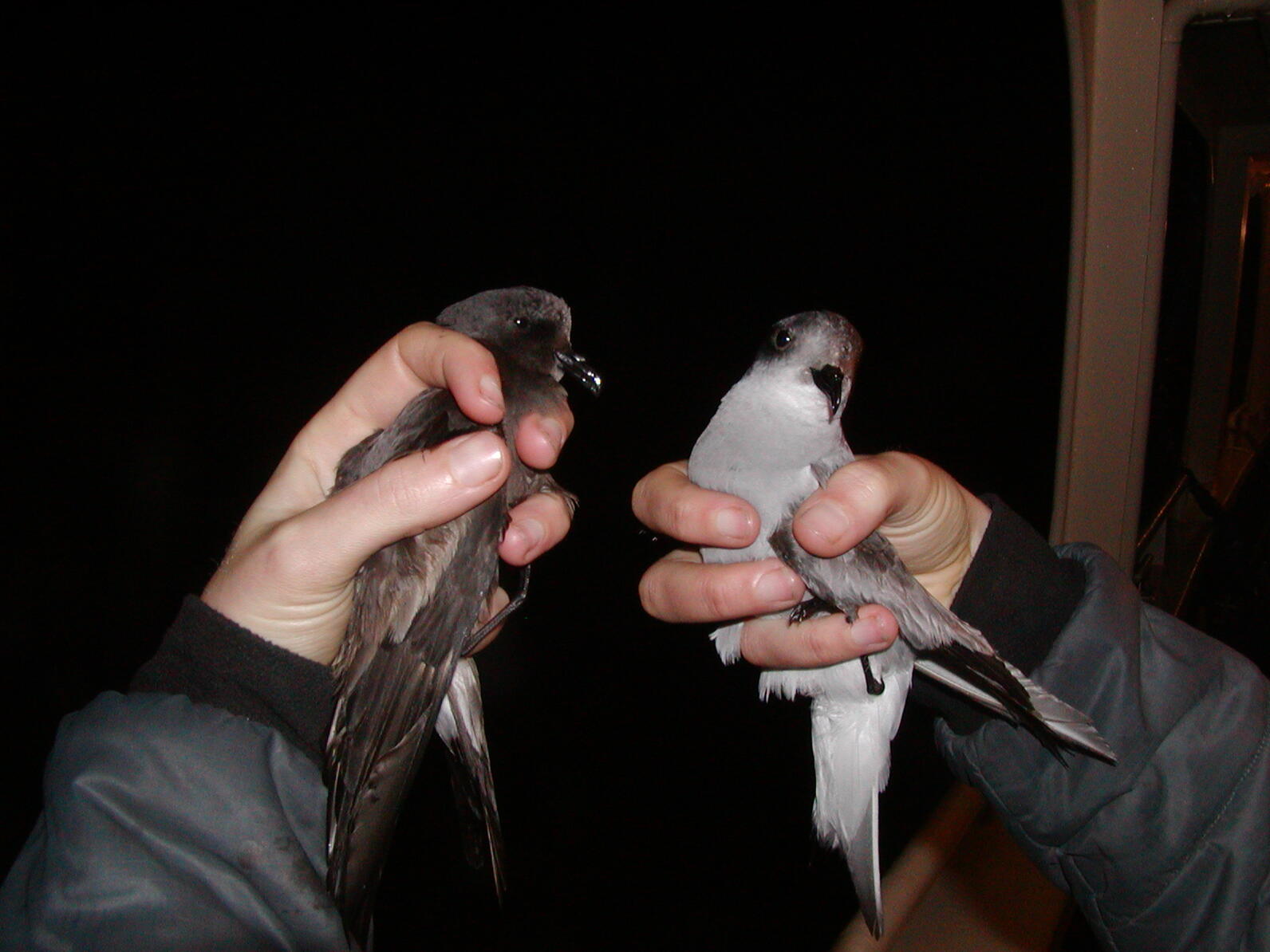
Looking Forward
For this team, the study is just a starting point. Kuletz says the paper wasn’t about population-level effects, “but the paper does recognize that there's going to be differences in impacts among species.” She recommends, for bigger picture studies, looking at the species. Rare species with small ranges, like Whiskered Auklet, could be impacted even with very little interaction.
Kapsar agrees. “If we were making a wish list, I really think some sort of monitoring network and reporting system, like Kathy was saying, for these bird strikes would be critical right now,” she says, noting there are anecdotal data sets of bird strikes, but no systematic way of logging them. “We can see there's vessels here, there's birds here, but we don't have a way of knowing what's happening.”
For Sullender, the work is also about dialogue with mariners. “We’re trying to sit down at the same table,” he says, “but in order to do that and walk through these issues, we need to be armed with data. And that’s what this paper provides. It's a good foundation for future conversations.”
Alaska’s seabirds have long weathered storms, darkness, and ice. Now, newer challenges can come in the form of steel hulls and glowing lights. With science, collaboration, and timely action, birders and mariners alike can help ensure these species continue to soar over our northern seas.









